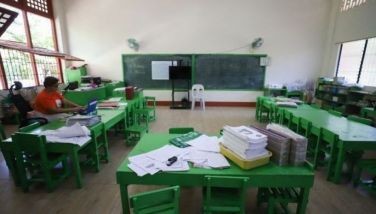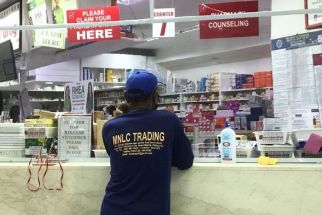Alert on in 33 MM dengue hot spots
MANILA, Philippines - The Department of Health (DOH) has turned on the “emergency mode” for dengue after declaring 33 hot spots for the mosquito-borne disease in Metro Manila.
“This (hot spot status) may progress into outbreaks and we don’t want that to happen. So on Monday, we’ll be starting simultaneous massive cleanup, larvaeciding and fogging operations in these areas,” DOH director for Metro Manila Dr. Ed Janairo said yesterday.
Quezon City accounts for most of the 33 hot spot areas, followed by Manila and Caloocan City.
Under the project, the DOH will work with barangay leaders and the Metropolitan Manila Development Authority that will be conducting de-clogging operations in the metropolis.
“We will focus first on the hot spot areas. We will kill mosquitoes and we will destroy their possible breeding sites to eliminate the larvae at the same time. We want to capture the mosquito cycle,” Janairo said.
The DOH had been coordinating with the Department of the Interior and Local Government (DILG), Department of Labor and Employment, and Department of Education to enjoin community leaders, employers and school officials to support the fight against dengue.
“This will be a region-wide campaign. We will be starting at 6 a.m. until 9 a.m. and then from 3 p.m. to 7 p.m. When you do dredging, you drive away the mosquitoes. We have to be there when they de-clog the canals to make sure that the mosquitoes won’t fly (everywhere),” Janairo said.
The agency is not advocating indiscriminate fogging operations in areas that are not critical for dengue.
“But since we are on emergency mode, fumigation will be done even in areas that are not yet hot spots for dengue. We have to do this to make sure that we curb dengue,” Janairo said.
“By mid-September, we expect dengue cases to go down significantly. We hope to repeat this campaign in December so that by next year, dengue cases will be minimized,” he said.
DOH records show that of the 45,333 dengue cases registered nationwide from Jan. 1 to Aug. 6, 10,487 cases came from Metro Manila. There were 267 deaths and 70 of them came from the National Capital Region.
As this developed, President Aquino yesterday allayed public scare on dengue as he cited government efforts to contain the spread of the deadly disease by conducting massive educational campaign and distribution of mosquito traps nationwide.
Aquino said the DOH reported a reduction of dengue cases in the country from more than 60,000 in 2010 to around 40,000 cases this year.
Citing DOH data, the President said an increasing number of cases were recorded in some areas but noted a decline in dengue cases from 20 to 25 percent nationwide.
Aquino was in Baguio City to lead the ceremonial lighting of energy-saving devices at Burnham Park.
The President said he instructed concerned government agencies to deploy more mosquito traps developed by the Department of Science and Technology (DOST) to fight dengue.
Each trap costs P10 and each household requires four traps. The trap kills 80 percent of the mosquito larvae and reduces the life of the remaining 20 percent to half.
At present, the government was able to distribute 250,000 traps for use of about 60,000 households.
The distribution of mosquito traps took some time as the government conducted invitation to bid, crafted rules of bidding and pre-qualification before the actual bidding for the contractors.
Aquino said he already asked the chairman of the Commission on Audit to look into the processes involved to speed up the deployment of the traps.
Aside from the traps, there is also a vaccine being developed to fight all four dengue strains although it has yet to be approved for actual use, the President said.
With regard to congested hospitals, he said there could be double reporting of cases because patients from other places were being brought to the National Capital Region for treatment.
Meanwhile, Science Secretary Mario Montejo said they are studying the possibility of producing “tawa-tawa” tablets to fight the dengue virus.
Montejo said the agency is currently conducting a study on whether “tawa-tawa” leaves can be used to increase the blood platelet level of a dengue patient.
He expressed hope that in a year’s time, the tablet forms of “tawa-tawa” would already be available.
“The DOST has been able to identify the active ingredient of ‘tawa-tawa’ to help maintain the blood platelet. The next step now is to make it into powder form,” said Montejo.
Victims of dengue fever suffer a low blood platelet level that lessens their capability to fight infection.
The DOST has been looking for ways on how to beat the dengue disease caused by Aedes aegypti mosquitoes.
Starting tomorrow, the agency will distribute 81,000 anti-dengue kits to public elementary and high schools in the cities of Quezon, Caloocan, Valenzuela, Manila, Pasig, Pasay and Muntinlupa.
The agency will also deliver mosquito traps in the provinces of Ilocos Sur, La Union, Benguet and some parts of Pangasinan.
Interior Secretary Jesse Robredo called on local government executives and barangay officials to conduct cleanup activities in their areas to help prevent the spread of dengue.
Robredo enjoined local officials to destroy all potential mosquito-breeding sites. - With Evelyn Macairan, Mike Frialde
- Latest
- Trending

























